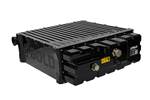Carbon fiber boosts dry-processed battery performance
ORNL researchers have found that dry-processed films incorporating long carbon fibers improves strength and conductivity for more affordable lithium-ion battery electrodes.
Although they barely cover a fingertip, these carbon fiber snippets are the longest to be incorporated into a battery film, enabling faster transfer of electrons. Source | Carlos Jones/ORNL, U.S. Department of Energy
Oak Ridge National Laboratory (ORNL, Tenn., U.S.) researchers have overcome a barrier to using a more affordable, dry process — incorporating composite materials — for manufacturing lithium-ion batteries used in vehicles and electronic devices. The resulting batteries have been found to provide greater electricity flow and reduced risk of overheating.
Dry processing is a method for making electrode films that eliminates the need for wet organic solvents that require increased factory floor space, time, energy, waste disposal and startup expenses. However, dry-processed films tear easily. So ORNL researchers , then tested coin cell batteries made from the material. They found the films were stronger and more flexible. The long fibers improved the mechanical strength of the material while transferring electrons further for faster charging and discharging rates.
While others have experimented with nanoscale carbon fibers, ORNL is the first to use long carbon fibers, says scientist Jaswinder Sharma. The chemical cost savings would exceed the price of the fiber, which constitutes only 1% of the weight.
“We think this is the next step in bringing dry-processed electrodes near to widespread use,” Sharma adds. “By eliminating expensive solvents and simplifying manufacturing, this method could help U.S. battery producers compete more effectively in the global market.”
The ORNL project is funded by the Department of Energy’s Advanced Materials and Manufacturing Technologies Office.
Related Content
-
Carbon fiber, bionic design achieve peak performance in race-ready production vehicle
Porsche worked with Action Composites to design and manufacture an innovative carbon fiber safety cage option to lightweight one of its series race vehicles, built in a one-shot compression molding process.
-
Welding is not bonding
Discussion of the issues in our understanding of thermoplastic composite welded structures and certification of the latest materials and welding technologies for future airframes.
-
Plant tour: Teijin Carbon America Inc., Greenwood, S.C., U.S.
In 2018, Teijin broke ground on a facility that is reportedly the largest capacity carbon fiber line currently in existence. The line has been fully functional for nearly two years and has plenty of room for expansion.






